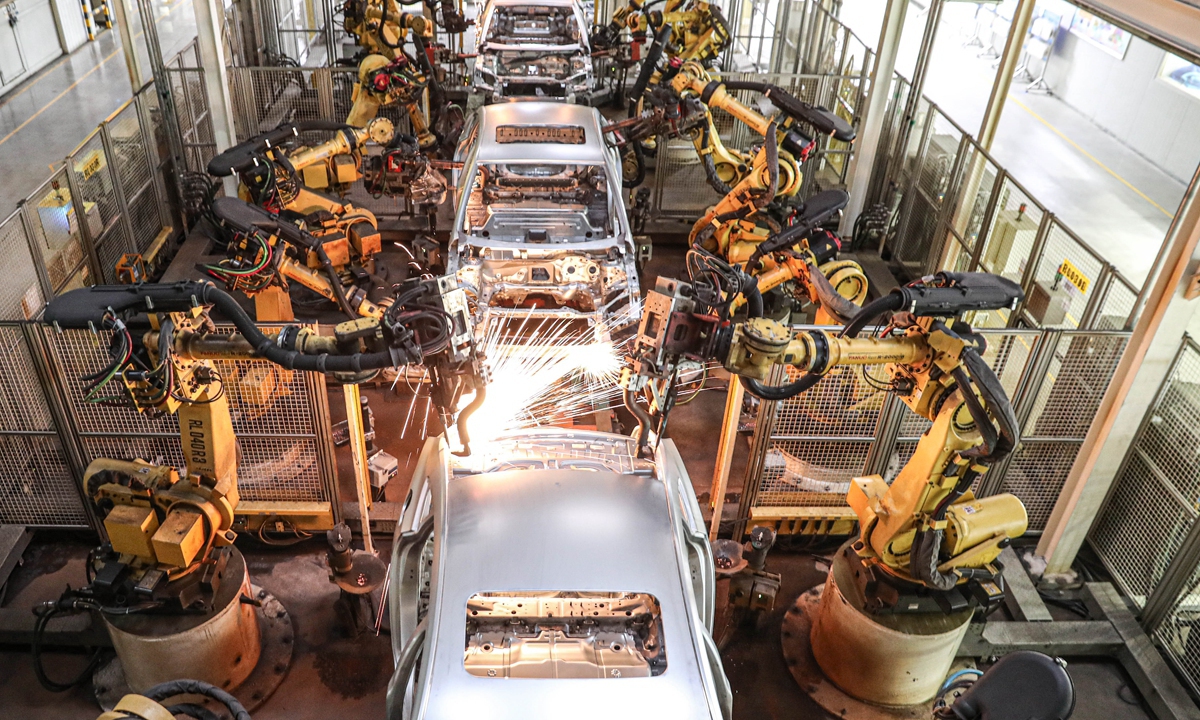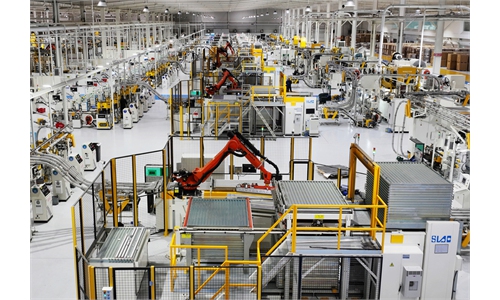
An automated production line at a car factory in Shenyang, Northeast China's Liaoning Province. Photo: IC
Despite the US-led "decoupling" efforts to weaken Chinese manufacturing capability, China's prominence in global supply chain and its endowed position as a leading global manufacturing hub in the world has not receded, if not substantially shored up thanks to the government's strenuous bid to shore up technology self-reliance.It is true that a country's economic growth and technology advance can never be begged or bought from others, as the world has witnessed since 2018 the ruthlessness of the US government to squeeze and impede hundreds of Chinese high-tech enterprises by cutting off crucial semiconductor and software supplies, as well as American investments.
However, Chinese enterprises' resolution to pursue a massive upgrade in manufacturing levels through innovations has only hardened, as they have spent hundreds of billions in the past years to bolster scientific research and development and integrate more innovations into a wide range of industrial fields. And, the country's continuous efforts to promote manufacturing upgrade and deepen opening-up will cement its status in the global supply chains.
And, it is necessary for the regulators to treat all types of enterprises equally, ensure policy stability and transparency, and most importantly, encourage innovations and fair competition to boost confidence of all market entities, especially those in the private sector. Such efforts will help unleash development potential of enterprises, to help expand the domestic market and quicken economic recovery, and eventually, to further leverage the country's advantages of a huge market to attract more foreign investors.
The country is expected to retain the cherished position as a crucial and the most important manufacturing hub as the supply chain diversification moves by a small group of governments and multinational companies are gradual and limited only to low-end sectors. It won't easy to "decouple" from China's giant and efficient manufacturing machine, economists say.
China remains a significant marketplace for a large number of multinational companies. Market confidence in the Chinese economy has been growing as the authorities have been ramping up efforts to adjust policies to revive the economy and support financing demands from companies of all sectors.
In addition to beefing up tech self-reliance, China should ratchet up efforts to strengthen international cooperation, such as creating a more equitable and level playing field for all types of market entities, and at the same time, it could leverage the advantages of its huge domestic market and manufacturing capability to attract more overseas investors, particularly in advanced industrial lines, consumer products and major service sectors.
Underpinned by China's increasing production of higher value-added products thanks to the government's sustained efforts to encourage manufacturing upgrades and movements up the global value chain, the country's share of global manufacturing production has continued to increase despite the US government's reckless "decoupling" or "de-risking" attempts. Public data showed that the country's share of global manufacturing output reached around 30 percent in 2022, compared with 28.5 percent in 2018 and 22.3 percent in 2012.
Some companies in labor-intensive industries are found to be relocating their production away from China as the country upgrades its industrial structure and moves up the value chain. Economists deem the phenomenon as "a normal thing," which had happened in many developed countries as they moved up the global industrial value chains.
Fitch Ratings released a report recently, which noted that the move by a small number of Chinese as well as international companies to relocate production away from China toward Southeast Asia and South Asia, such as Vietnam, Thailand, Malaysia and India amid rising trade barriers and geopolitical tensions remains limited to sectors involving low-skill assembly and mass production, like textiles, toys and footwear. But higher value-added production like advanced machinery and electronics production remains in China.
In the past several years, Chinese industries have made steady progress in high-tech manufacturing production, including machine tools, meters, electric automobiles, batteries, solar panels, wind turbines, nuclear power reactors, mining excavators and underground borers, high-tech planes and satellites, sophisticated ocean ships and vessels, as well as advanced semiconductors, robots and more.
According to the Fitch report, the so-called "supply chain shift" ought to be a gradual process, as "China's competitive advantages of a large and relatively high-skilled workforce, well-developed infrastructure, industrial expertise and efficient and complete manufacturing value chain" are unlikely to be "overtaken by other countries" in the near future.
By all metrics, Chinese market is huge and rapidly evolving with great development potential and no global corporation could take a market as big as China's for granted. For example, the number of Chinese smartphone users is about 3 times that of the US, and mobile internet users are more than 8 times in America, which means the size of China's mobile commerce is nearly 5 times of the US. With regard to electric vehicle consumption, China consumers bought up to 8.5 million EVs in 2023, compared to 1.1 million EVs bought by Americans last year.
Chinese industrial enterprises have been accelerating investment on technological innovations in the past years so as to move up the global value chains, making made-in-China products more competitive in quality and prices, which constantly bolsters the importance of Chinese manufacturing and renders it indispensable for many economies. For instance, Chinese companies own the world's best battery-making technology and other materials and accessories needed by overseas EV makers.
Despite some developed economies increasingly leaning toward protectionism and isolationism, China has consistently stuck to high-standard institutional opening-up and is seeking to mingle closer with and integrate deeper into the global industrial and supply chain, through the Belt and Road Initiative, multilateral free trade agreements and other proactive action plans, which will increase the resilience to Chinese market's distinct appeal to overseas investors.
On a related front, Chinese enterprises could also be encouraged to boldly take the "going global" approach to expand their footprint and presence in overseas markets. This way could lead to intertwined industrial tethers with the international market, which proves to be a potent step to strengthen Chinese enterprises' strength in global supply chains. Lately, Chinese EV and battery makers are setting up plants in Thailand, Mexico and Europe.
The author is an editor with the Global Times. bizopinion@globaltimes.com.cn


